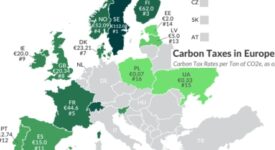The European Union and the United States are dangerously dependent on China for many raw materials that are critical to their green and digital transitions. Although they have begun to pay greater attention to the challenge and to reduce this dependency, they are still vulnerable to economic coercion. The most glaring flaw in their current approach to building resilient supply chains is a lack of sufficient transatlantic cooperation. Such cooperation was at the core of the Western response to the oil shock of 1973. That year, the onset of the Yom Kippur war prompted a group of Arab states to place an embargo on oil exports to countries they deemed friendly to Israel, reducing the global supply of the product by 14% and tripling its price. This was a wake-up call for European countries, the US, and their allies. They responded by reducing their collective dependence on Middle Eastern oil and improving the resilience of their supply chains – implementing strategies based on domestic energy independence and trade diversification, and establishing a framework of action for future supply disruptions.
Today, China controls around 80% of the world’s production of rare earth materials, a group of minerals used in electric vehicles, wind turbines, military weapons systems, and a variety of other advanced technologies. The country accounts for 98% of EU imports, and 80% of US imports, of rare earths. Beijing has described rare earths as a “strategic resource”, and it has sometimes used its exports of these materials as a trade weapon. In 2010 China cut off all exports of rare earths to Japan in response to an incident in waters near the contested Senkaku/Diaoyu Islands. Following this instance of economic coercion, Japan reduced the Chinese share of its imports of rare earths from 91.3% to 58% in less than a decade. The EU and the US failed to adequately respond to a similar challenge between 2009 and 2011, when China imposed strict export quotas on rare earths – which are critical to Western countries’ industrial competitiveness and green and digital transformations. This led prices of rare earths to rise by more than 700%. China’s export quota system ended in 2015 (following a series of disputes at the WTO). But, despite seeing China’s outsized power in the market, neither the EU nor the US reduced their dependence on Chinese rare earths in this period.
Nonetheless, in a May 2021 update to the EU’s industrial strategy, the European Commission published a document on strategic dependencies and capacities that identifies 30 critical raw materials for which the bloc is highly dependent on imports from third countries. The following month, the White House published a comparable report on building resilient supply chains, which identifies the same strategic dependencies, dedicating an entire section to 35 critical minerals. Both reports map supply chains, conduct risk assessments of these dependencies, and outline similar approaches to reduce the risk of economic coercion and build greater supply chain resilience by boosting domestic supply and research and development.
Indeed, increases in domestic supply have been at the centre of EU and US efforts to counter economic coercion more broadly. The European Commission is working with EU member states to identify mining and processing projects in the bloc that could become operational by 2025. The EU has also launched the European Raw Materials Alliance to identify barriers, opportunities, and investments in this area. And the US has developed the Strategic Materials Assessment and Risk Topography, a digital tool for tracking domestic facilities that currently produce or could produce strategically important materials. Both powers want to invest in greater geological mapping – to better understand their potential domestic production capacity – and to adopt policies on recycling critical materials. In the EU, Horizon Europe supports research and innovation on new mining and processing technologies, substitution, and recycling. Following a similar approach to research and development, the US report discusses grants, loans, loan guarantees, and other economic incentives to establish industrial capacity, subsidize markets, and acquire materials.
Both strategies call for greater international cooperation, but their accompanying commitments are unambitious and unfulfilled. While there are too few non-Chinese suppliers of critical raw materials, and while a major disruption in the supply of these materials is likely, the EU and the US still lack a common diversification strategy and a shared approach to responding to a crisis. The lack of a common framework not only leads to inefficiencies but could also increase transatlantic competition during severe supply disruptions. If the EU and the US want to reduce their vulnerability to China’s use of rare earths for economic coercion, and to effectively respond to supply shocks, they will need to improve the resilience of their supply chains for critical raw materials.Their Trade and Technology Council – which met for the first time in Pittsburgh in September, and which includes a working group on supply chains – is the perfect framework in which to address the challenge.
There are three main elements to this. Firstly, the EU and the US should cooperate to enhance their independence and ramp up domestic production through a joint research and development agenda – one that covers recycling, efforts to anticipate changes in supply and demand, geological mapping, and sustainability standards. Secondly, they should outline a common approach to diversification and a strategy that establishes their international investment priorities, extraction standards, and potential venues for joint projects, as well as methods to de-risk private investments. Thirdly, the EU and the US need to commit to a framework for adjusting supply chains or increasing domestic production when China targets one or both of them with supply disruptions. This framework should set out effective ways to create strategic reserves of critical raw materials.
Forty-eight years ago, an oil embargo radically changed Western states’ view of commodities geopolitics. This forced them to come up with creative and courageous solutions to problems in their supply chains. Today, the EU and the US need to learn from this experience by developing an ambitious diversification and cooperation agenda in the framework of the Trade and Technology Council. Only then will they address their vulnerabilities, increase their capacity to respond to shocks, and reduce the risk that disruptions will lead to transatlantic competition.
‘Critical Mass: Raw Materials, Economic Coercion, and Transatlantic Cooperation’ — Commentary by Pau Ruiz Guix — European Council on Foreign Relations / ECFR.







